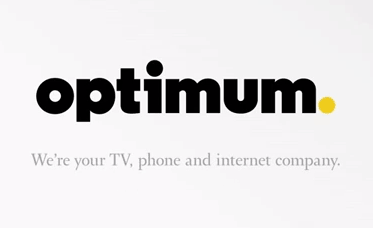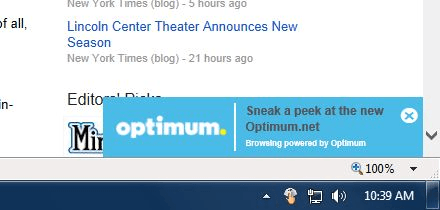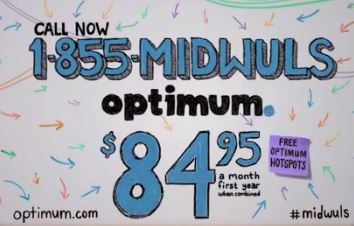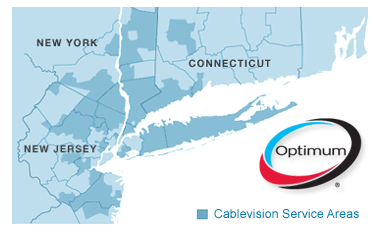 Cablevision broadband customers are likely to see some new, faster upload speeds from the cable operator between now and sometime in July thanks to ongoing competition from Verizon FiOS.
Cablevision broadband customers are likely to see some new, faster upload speeds from the cable operator between now and sometime in July thanks to ongoing competition from Verizon FiOS.
Employees are informally telling Stop the Cap! the cable company has already dropped the “go-away” $300 installation fee for the company’s highest speed Ultra tiers and is set to formally introduce these packages this summer:
- Optimum Online Basic gets an upload speed boost. The 15Mbps download speed stays the same, but the 2Mbps upstream speed increases to 5Mbps;
- Optimum Online Boost will be retired. The 30/5Mbps service was Cablevision’s “turbo” tier, but now customers will be encouraged to consider faster packages;
- Optimum Online Boost Plus will be reintroduced as Optimum Ultra 50. The download speed remains 50Mbps, but upload speed is going up from 8Mbps to 25Mbps;
- Optimum Ultra also gets an upload speed boost. The 101/15Mbps tier becomes 101/35Mbps.

Courtesy: Sutheras
Cablevision did not get back to us in time to confirm the changes, but multiple sources have told us they are imminent.
Customers might appreciate the new speeds, but we’ve also heard from several readers Cablevision is now injecting ad banners into the browsing experience.
“I just started seeing advertisements for Optimum’s new website at the bottom of my screen, regardless of what web page I visit,” writes Dean Portew. “It just started happening and the ads disappear sometimes as quickly as they appear and Cablevision claims to not know anything about it.”
Reviewing the terms of service for Cablevision, the cable company doesn’t call it a web browser ad injection, they call it watermarking and to quote Det. Joe Fontana from the late Law & Order, “we’re authorized.”
32. Watermarking:
Subscriber understands and agrees that Cablevision may use “watermarking” techniques to message you about your account, Optimum services or for other communication purposes while using the Optimum Online Service. These “watermarks” may appear superimposed from time to time over portions of website pages you visit while using the Optimum Online Service, however, you understand and agree that this in no way indicates Cablevision’s approval of or responsibility for the content of such websites, which are solely the responsibility of the website operators and/or content providers. You further agree that you will not seek to hold Cablevision responsible in any way for any third party website content or the operation of any third party website accessed via the Optimum Online Service, or for the appearance of an Optimum “watermark” over a portion of any website.
A number of customers are not too happy about the intrusion, judging from an active discussion on DSL Reports’ Cablevision forum.


 Subscribe
Subscribe

 The project in New Jersey is not anticipated to be complete until 2016. Wi-Fi will first be made available in railway stations. Individual railway cars will then gradually get the service.
The project in New Jersey is not anticipated to be complete until 2016. Wi-Fi will first be made available in railway stations. Individual railway cars will then gradually get the service. One of America’s lowest-rated cable companies and an industry legend labeled by consumer advocates as the “Darth Vader of cable” may be joining forces to buy Time Warner Cable, according to Bloomberg News.
One of America’s lowest-rated cable companies and an industry legend labeled by consumer advocates as the “Darth Vader of cable” may be joining forces to buy Time Warner Cable, according to Bloomberg News.
 But the most obvious foreshadowing of a big deal with Time Warner would most likely come if Charter first successfully acquires always-rumored-for-sale Cablevision, where the controlling Dolan family is rumored to be holding out for an exceptionally attractive buyout package other cable companies aren’t willing to offer. Time Warner itself has been rumored as a buyer, but current management has repeatedly stressed it will not pay a premium price for acquisition targets.
But the most obvious foreshadowing of a big deal with Time Warner would most likely come if Charter first successfully acquires always-rumored-for-sale Cablevision, where the controlling Dolan family is rumored to be holding out for an exceptionally attractive buyout package other cable companies aren’t willing to offer. Time Warner itself has been rumored as a buyer, but current management has repeatedly stressed it will not pay a premium price for acquisition targets. Cablevision will maintain unlimited Optimum Online broadband service to all of its customers and will not introduce usage-based pricing, according to Gregg Seibert, chief financial officer.
Cablevision will maintain unlimited Optimum Online broadband service to all of its customers and will not introduce usage-based pricing, according to Gregg Seibert, chief financial officer.